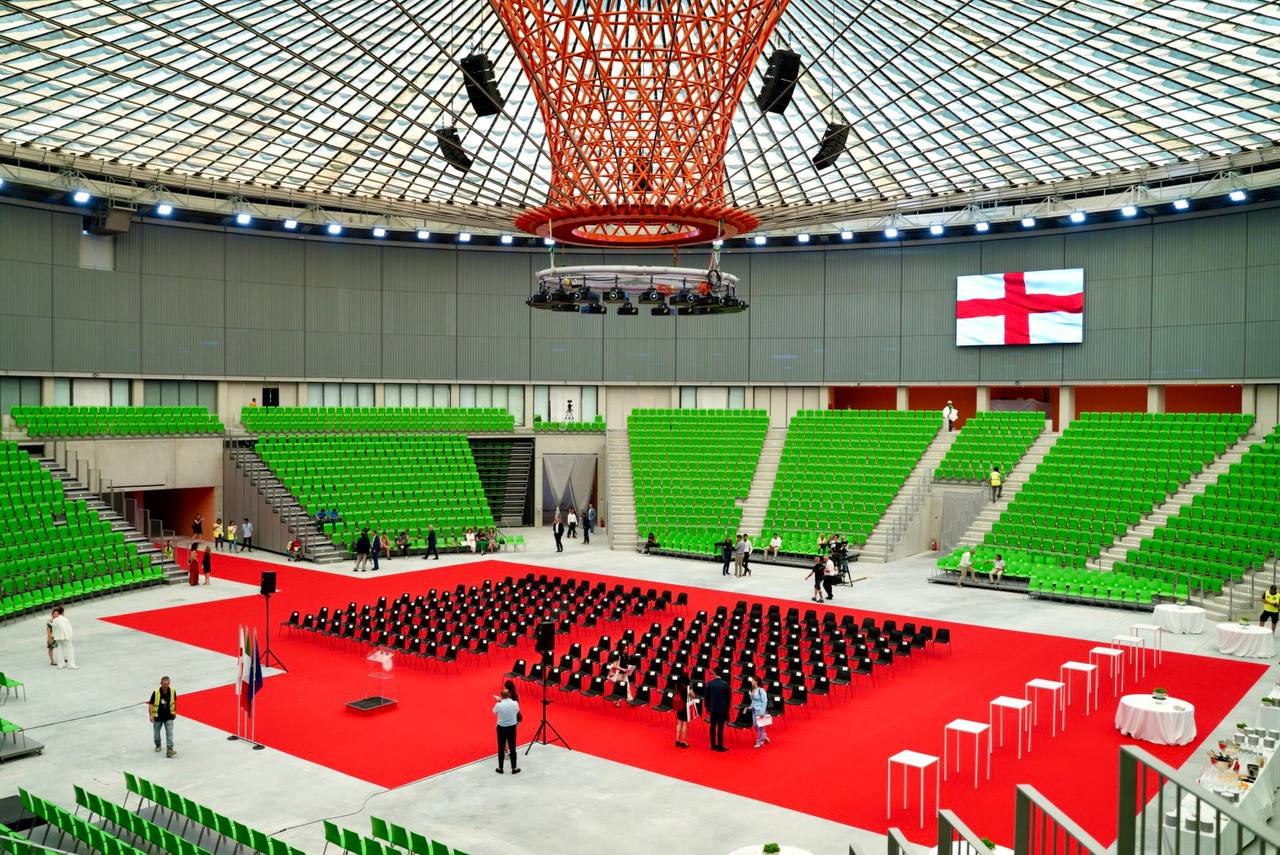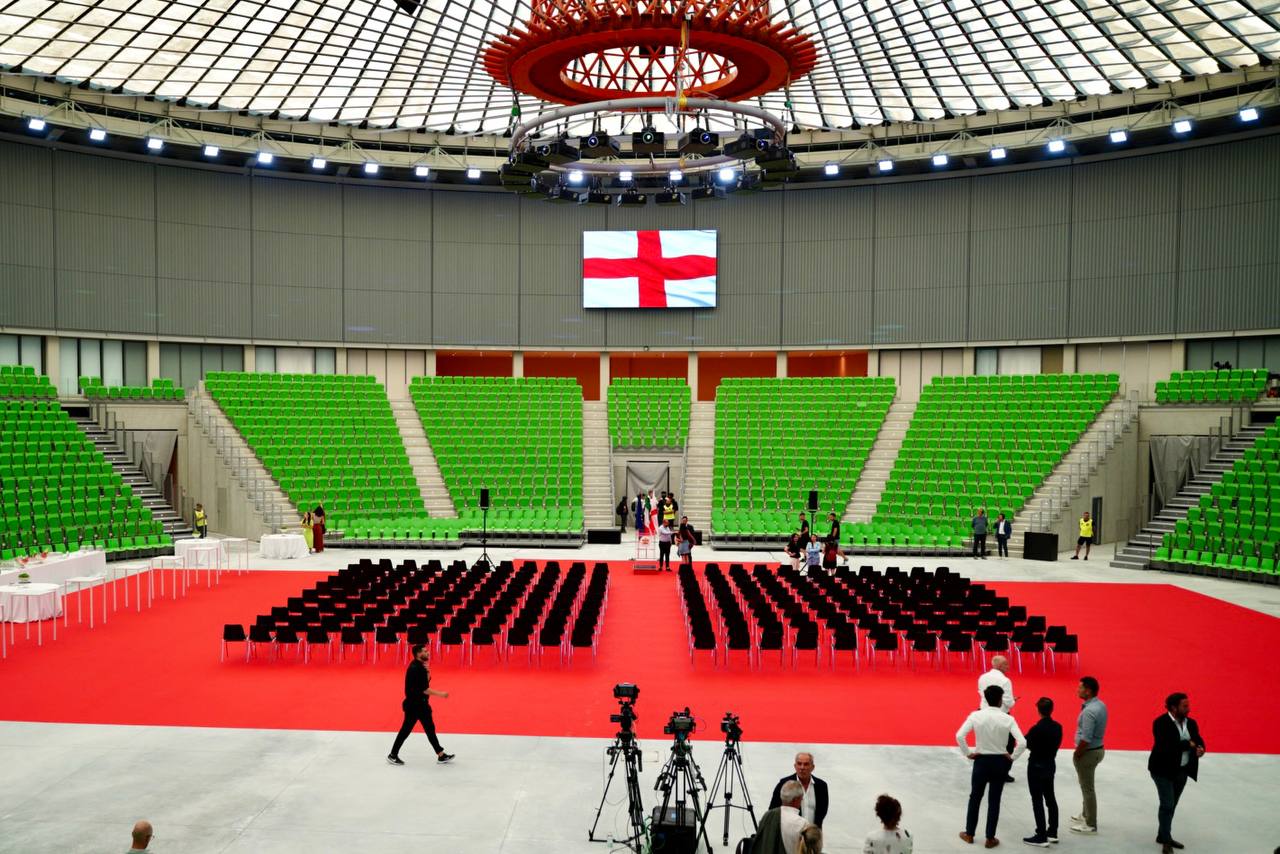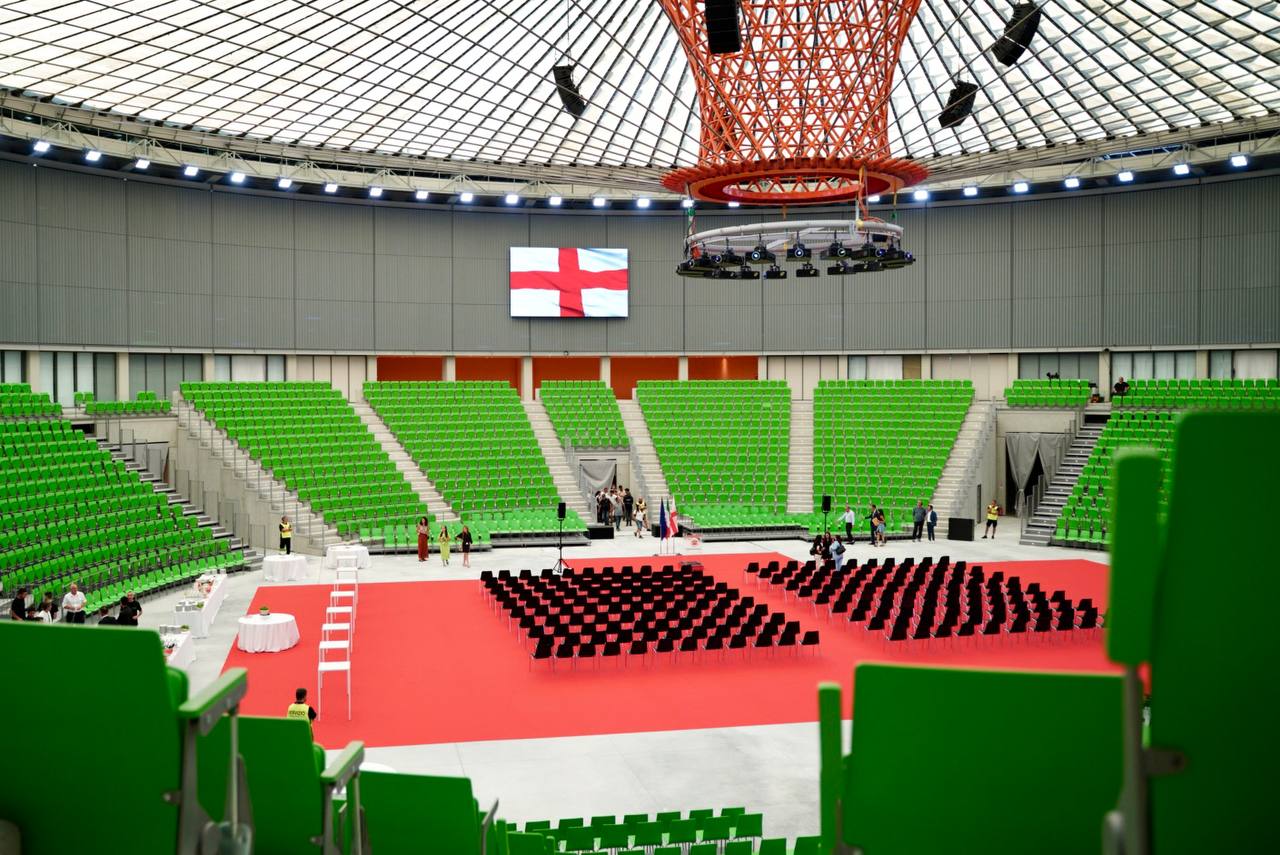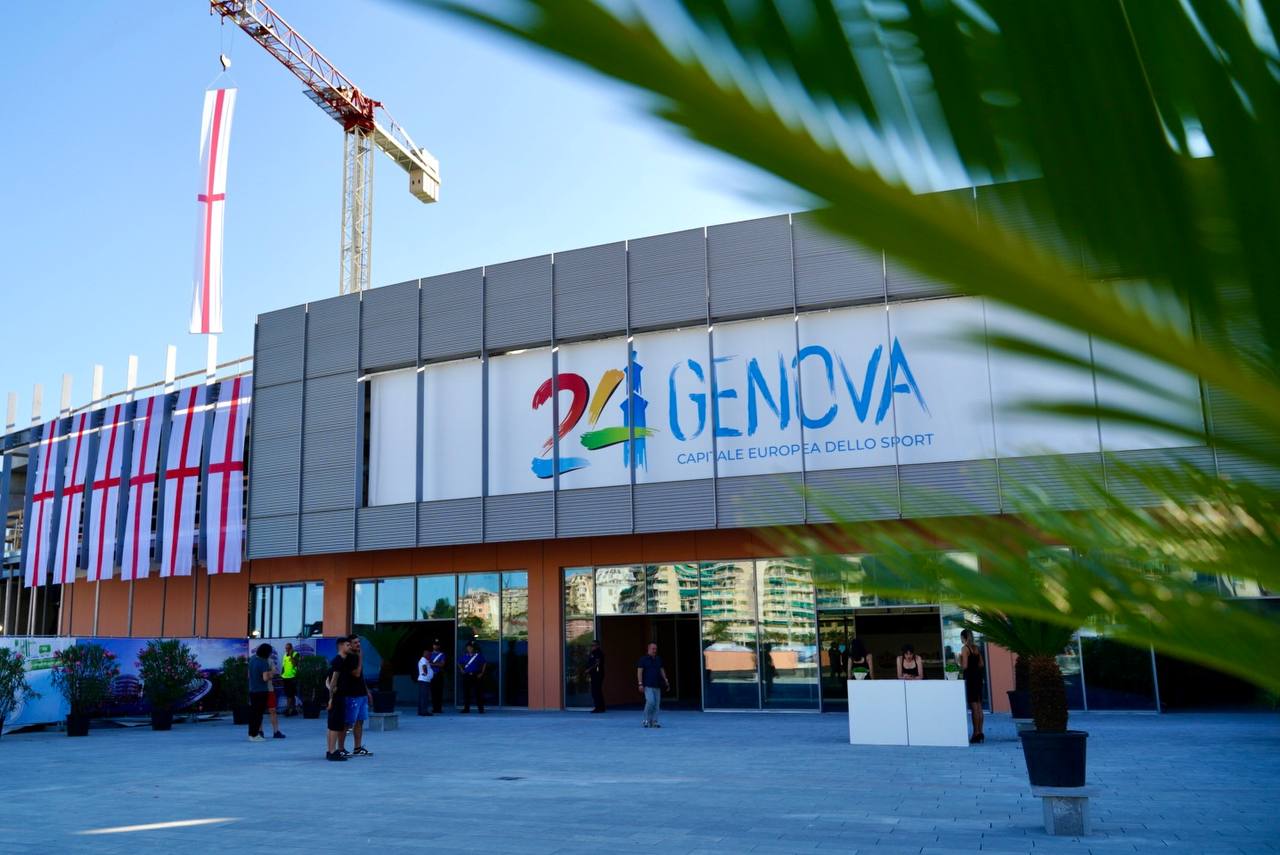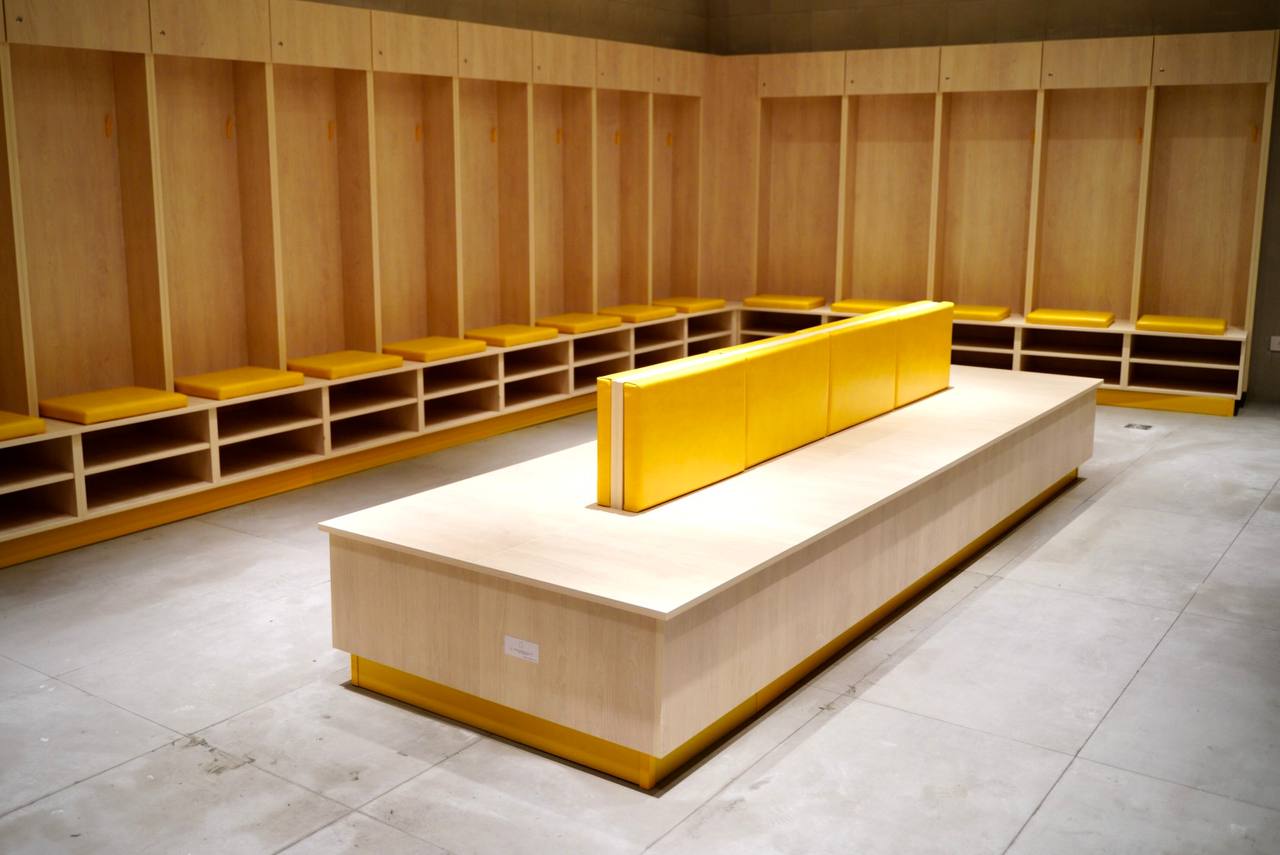Palasport, the new sports arena of the Waterfront di Levante presented
The new facility is spread over 3 above-ground floors and can accommodate up to 5,000 spectators distributed across 8 circular stands. The new arena, designed by RPBW Renzo Piano Building Workshop, complies with CONI and FIP GOLD regulations; it is fully autonomous and directly accessible from the public square in front of the main entrance of the complex. Inside, a 1,800 sqm sound-absorbing wall ensures optimal acoustics and can be used for 360° projection of videos and images. The internal stands are divided into four fixed stands and four telescopic stands, allowing the central parterre area to be modified according to the training needs of local federations, events, and exhibitions.
This evening, the sports arena inside the Palasport of Genoa, a symbolic building for the city and the gateway to the new Waterfront of Levante, was presented to the press and authorities.
The arena project is signed by RPBW Renzo Piano Building Workshop. The sports arena has been conceived as an open and flexible space, with the ability to adapt to the events that will take place there. The central space can therefore alternatively host: training activities of local federations, concerts, and trade shows. In the case of national and international sports events, it can accommodate up to 5,000 visitors.
Following constant work between designers and Coni Liguria, the arena has been designed according to the requirements of the major sports disciplines (12). In addition to daily use for training and sports practices, the Palasport can host regional and national events (futsal and large futsal, skating, and handball) up to international ones (basketball, volleyball, tennis, martial arts, artistic gymnastics, rink hockey, badminton, sports dance, and fencing).
“This Palasport,” declares the mayor of Genoa Marco Bucci, “is not just a place for sports, but a multifunctional hub that can adapt to the changing needs of our community. The versatility of the internal spaces allows for hosting various sports disciplines, improving the accessibility and use of our facility. We wanted to ensure a superior experience for spectators and athletes. From the quality of the seating to the advanced acoustic technology, every detail has been taken care of to create a welcoming and stimulating environment for all those who will cross the thresholds of this renovated Palasport. A thank you to all those who have worked tirelessly to realize this project.”
“A great work symbolizing sport as a driver of economic development and social aggregation,” says the interim president of the Liguria Region Alessandro Piana, “promoting fundamental values in an international network, through the various federations, and developing the many disciplines that see great champions and many young people as protagonists. We will thus be able to enrich the calendar of our events, becoming a consolidated point of reference and offering more and more to citizens and tourists. This new Palasport, Genoa Capital of Sport for 2024, and Liguria European Region of Sport in 2025 will be the main pillars of a further challenge for our region, which will further shorten the distances between great champions and the public, as well as enhance all associations and types of events. The Palasport will be the venue for major events, highlighting all categories and the authentic spirit of sport.”
“It is a historic day for Genoa: today we present the sports arena of a completely renovated Palasport, with an operation that enhances the public function in a mix of sports and major events, with a strong focus on sociality and sports activities, in the name of accessibility, the most advanced green technologies, and therefore sustainability,” emphasizes the deputy mayor and councilor for public works Pietro Piciocchi. “In these years, we have seen the great urban suggestion of architect Renzo Piano grow, piece by piece, and take shape, whom I thank for meticulously following every step of the new Waterfront of Levante, with the aim of returning a living space to the city, in the name of sociality and the bond between Genoa and its sea, with attention to future generations who will find spaces for sports and entertainment here, but also where they can shape their projects in the Factory of Ideas. I thank the workers, architects, and the entire team of Cds Holding spa and RPBW Renzo Piano Building Workshop for the work of these months and for the work of the coming months to complete the Waterfront.”
“It is also an important piece within Genoa 2024 European Capital of Sport,” adds the councilor for Sport and Tourism Alessandra Bianchi. “We wanted to return this facility in this important year for Genoa, which will live a lot on basic activities in conjunction with major national and international events, sports and non-sports, in an extraordinary setting like the Waterfront of Levante, which also benefits from the presence of Jean Nouvel and the Casa della Vela and an entire context that further amplifies the value of sport also in a tourist key.”
“Multidisciplinarity, eco-sustainability, managerial balance, compliance with current regulations and new technical-sporting needs, usability by citizens, some of the aspects I want to emphasize about the sports arena, a characteristic element of the Palasport and the Waterfront of Levante,” emphasizes the president of Coni Liguria Antonio Micillo. “Talking about the rebirth, because that is what it is, of this sports facility that has been part of the history of the City of Genoa is for me a reason for emotion and pride. Coni Liguria has tried to make its expertise available to create a facility that can daily accommodate ‘grassroots’ sports up to top-level sports. Now it is up to the Genoese sports world to take up the challenge of maximum use of the facility, which can happen in the presence of a high-level professional manager. A thank you to the municipal administration that strongly wanted the recovery of the sports arena, to the Piano studio for the passionate and engaging design intervention, and to CDS who knew how to intervene and concretely realize the facility, responding to the complex needs that arise today in building new sports structures.”
The Project
The sports facility is spread over one underground level and three main above-ground levels. The underground level houses the access system with spaces that can be used as ticket offices. On the ground floor, there is the sports practice area: under the stands are the locker rooms, rooms for clubs, the first aid room for athletes, anti-doping room, storage for wheelchairs for disabled athletes, locker rooms for referees and officials. The locker rooms comply with CONI and FIP GOLD regulations.
The facility will be equipped with sports equipment as per FIP regulations for two playing fields (one GOLD and the other SILVER). The training area will have FIBA-certified parquet flooring, while a certified removable field will be set up in the center of the arena for national events. The sports equipment will be completed by 2 information screens that will also serve as scoreboards. On the second floor, there is a multifunctional space of about 1,000 square meters that can be used for sports activities, events, and conferences. The facility will have an underground parking lot with 800 parking spaces.
The project, in line with the original scheme – the structure was built in 1962 based on a design by the group led by engineer Leo Finzi – features circular stands distributed over 8 petal-shaped tiers, 4 of which are fixed and 4 retractable. The seats are distributed along 15 concentric circles that reflect the geometries of the existing building, enhancing its shape.
To ensure the required acoustic standards, the perimeter of the arena is covered with a high-performance sound-absorbing wall, about 1,800 square meters. The wedge-shaped panels are made of polyester fiber covered with perforated aluminum sheet: the light gray cylindrical surface defines the space of the sports arena and also characterizes it architecturally.
The perimeter of the arena serves as a 360° screen for the projection of videos and images, transforming the sports arena into an immersive space. The new sports arena is equipped with a perimeter lighting system at the top of the sound-absorbing cylinder: 76 high-performance projectors will ensure the lux levels required by the reference standards and will be positioned to avoid glare for spectators and players.
The facility is equipped with sports equipment as per FIP regulations for two playing fields (one GOLD and the other SILVER). The training area will have FIBA-certified parquet flooring, while a certified removable field will be set up in the center of the arena for national events. The sports equipment is completed by two information screens, which will also serve as scoreboards.
In line with the general master plan of the area, the new Palasport will be able to meet most of its energy needs through the use of renewable sources. The portion of the roof, generated by the expansion of the building’s outer ring, will serve as a base for the installation of a photovoltaic system (2,800 square meters) and a system of exchangers with seawater will power the cooling/heating machines of the building.
The main access to the sports arena is at ground level from the main entrance of the building located to the northeast, while the entrance for visiting fans will be from the south entrance via the stair ramps leading to the underground level and from there directly to the guest sector. The facility has 8 elevators, two for each access route to the arena: four are dedicated to players and four to spectators. The two internal elevators in the spectator area connect level -1 to level 2, ensuring accessibility to all levels of the sports facility.
PALASPORT PROJECT CREDITS
INVESTOR AND DEVELOPER: CDS Holding S.p.A. CEO and Partner: Enzo DanesiCOO and Partner: Enrico Biffi
General Director: Massimo Moretti
Orion Capital Managers Managing Director Italy and Partner: Corrado Trabacchi
TEAM: General Contractor: CDS Costruzioni S.p.A.
Architectural Design for Thematic Commercial District: Starching
Architectural Design for Sports Arena: RPBW Renzo Piano Building Workshop and Vespier Architects
Architectural Design for Facades and External Areas: RPBW Renzo Piano Building Workshop and OBR Consulenza
Landscape Design: AG&P Greenscape
Project Monitoring: Europtima, Archire
Project Management: Starching
Structural Design: Struttura Continua
Systems Design: Manens (Sports Arena) and Studio Zenucchi (Thematic Commercial District)
Acoustic Design: Manens and HMBA (Sports Arena) and Canepa (Thematic Commercial District)
Theatrical Design for Arena: HMBA
Fire Safety Design: Studio Tecnico Zaccarelli
Traffic Design: TRM Group

